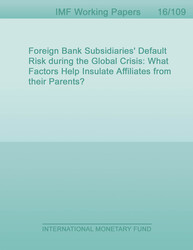
Foreign Bank Subsidiaries’ Default Risk during the Global Crisis : What Factors Help Insulate Affiliates from their Parents?
This paper examines the association between the default risk of foreign bank subsidiaries in developing countries and their parents during the global financial crisis, with the purpose of determining the size and sign of this correlation and, more importantly, understanding what factors can help insulate affiliates from their parents. We find evidence of a significant and robust positive correlation between parent banks’ and foreign subsidiaries’ default risk. This correlation is lower for subsidiaries that have a higher share of retail deposit funding and that are more independently managed from their parents. Host country bank regulations also influence the extent to which shocks to the parents affect the subsidiaries’ default risk. In particular, the correlation between the default risk of subsidiaries and their parents is lower for subsidiaries operating in countries that impose higher capital, reserve, provisioning, and disclosure requirements, and tougher restrictions on bank activities.
Publication date: June 2016
ISBN: 9781484382189
$18.00
Add to Cart by clicking price of the language and format you'd like to purchase
Available Languages and Formats
| English |
Prices in red indicate formats that are not yet available but are forthcoming.
Topics covered in this book
This title contains information about the following subjects.
Click on a subject if you would like to see other titles with the same subjects.
Economics- Macroeconomics , Economics- Macroeconomics , Economics / General , Economics / General , International - Economics , International - Economics , Banking crises , default risk , ring-fencing , bank subsidiaries , distance to default , Merton model
Summary
Copyright © 2010 - 2024
Powered by:
AIDC



